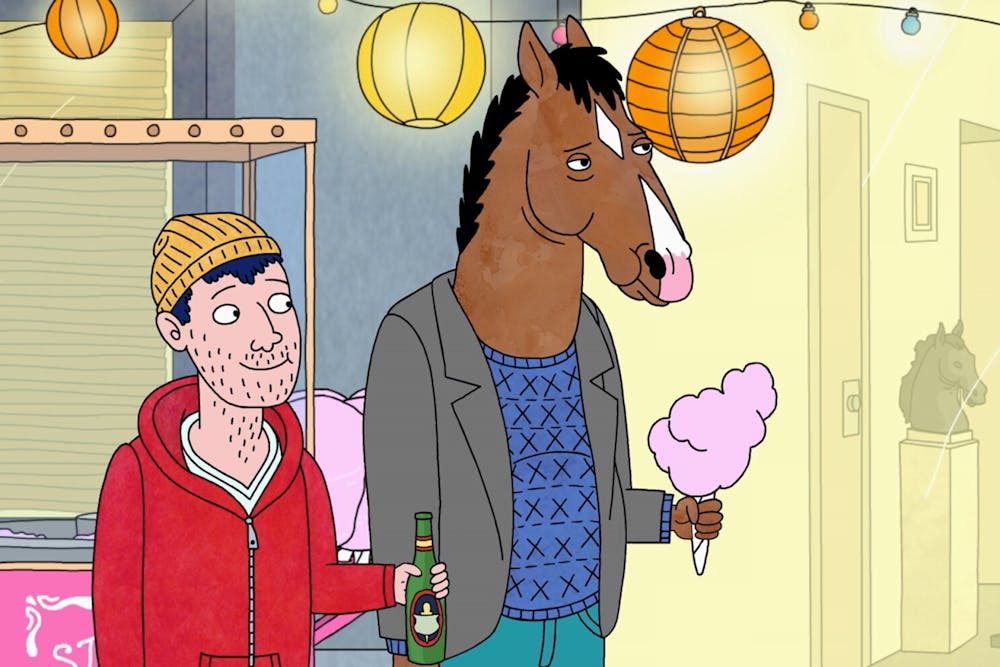Few tales are told as uniquely as “BoJack Horseman.”
Telling the story of a washed-up anthropomorphic equestrian actor in his mid-50’s, “BoJack” is so many shows wrapped into one. It’s a comedy, a drama and a love letter to all things Hollywood. Showcasing a blend of anthropomorphic animals and humans that coexist in a most hilarious fashion, the series truly is a concept that could only work in animation.
But the lighthearted concept and colorful animation are more than just tools used to craft a creative world: they are a façade to pull viewers into one of the darkest stories in the history of television.
BoJack does not pull his life together like other washed-up protagonists. Not even close. “BoJack Horseman” follows a series of increasingly bad decisions. BoJack’s struggles with addiction, childhood trauma and the results his toxic habits have on his loved ones is anything but glorified, as the protagonist’s view on the world becomes more skewed with each season.
Yet somehow, not even a story this depressing can stifle a boatload of laughs. Where one moment, viewers could be treated to some of the darkest television ever put to screen, mere seconds later they may find themselves laughing uncontrollably — an unimaginably perfect balance of genres.
But the show has one quality which sets it above the rest: its“out-of-genre” episodes.
It’s a concept as old as television itself. Whether it be a Christmas special that centers on a less important character’s point of view, or a retrospective, nearly every television series has ventured out of its style to tell a story differently.
But for the writers of “BoJack Horseman,” this is the comfort zone.
While the first and second seasons are relatively traditional in the realm of adult cartoons, the series begins to shift at the end of the second season.
Initially, it just seems that the show is doing a few “different” types of episodes. Ranging from a flashback depicting all the characters in 2007 to an episode where the characters are unable to speak (utilizing sound and visuals in a most beautiful elegance), it seems by the show’s end, that “out-of-genre” is the genre.
Even some of the darkest and most pivotal moments in some characters’ arcs can be masked by a cheerfully funny out-of-the-box concept. One episode in particular — season 4 episode 9: “Ruthie” — starts off with a concept that would fit into any Disney movie: a child giving a class presentation on her grandmother — one of the show’s main characters — and an awful day she had. While this at first appears to be just another episode using a gimmick to keep the plot moving, the story tumbles into unexpectedly heart-wrenching themes as the character’s day gets exponentially worse, forcing the audience to wonder how the show could ever use such a weirdly positive episode setup for something so messed up.
The show’s more adventurous episodes do more than just change the way the story is told however, with many instances even utilizing alternative art styles to tell the story.
One such example comes in the form of season 4 episode 8: “Stupid Piece of S—t,” an installment which focuses on BoJack’s self-loathing internal dialogue. The saddeningly accurate voice in BoJack’s head is complemented anytime it speaks with a crude art style depicting the people he thinks about. Like the internal voice, the art feels lowly and improvised, helping to amplify the negativity BoJack sees within himself.
It feels comical to think about how dark a plot of this tone can produce some of the loudest laughs ever put to the small screen, but it’s true. Even crazier to think is how dumb these comical moments are, especially when put next to topics as serious as depression and abuse. Yet somehow, the writers manage to weave plotlines like the desperation for achieving validation with hilarious stories like starting a company that sells spaghetti-strainer-hats (yes, that is exactly what it sounded like) in seamless form.
It feels like a big shame that “BoJack Horseman” ended when it did. Yes, six seasons is a healthy lifespan for any series. And yes, every character unquestionably received the ending they deserved. But a show with this much creativity could easily have lasted for many more years.
For anyone who has never seen the series before, it is worth mentioning that the show’s darker themes can be painfully accurate in certain situations, so anyone who finds themselves easily triggered by depressing events should go into the series with caution.
That’s not to say there isn’t a light at the end of the tunnel. Maybe the show doesn’t give every character the ultra-happy ending fans may have hoped for, but the way in which their arcs are wrapped up feel fitting in the lessons they teach, and give enough closure to leave viewers satisfied.
“BoJack Horseman” may never receive the recognition of shows like “Breaking Bad” and “The Sopranos,” but that has nothing to do with its quality. For all intents and purposes, “BoJack Horseman” is one of the greatest television shows of all time, acting as a masterful example of blending genres to tell a story in a remarkably creative way.
Alex Falter is the senior arts editor and can be reached at alex.falter@ubspectrum.com

Alex Falter is a senior arts editor at The Spectrum.





